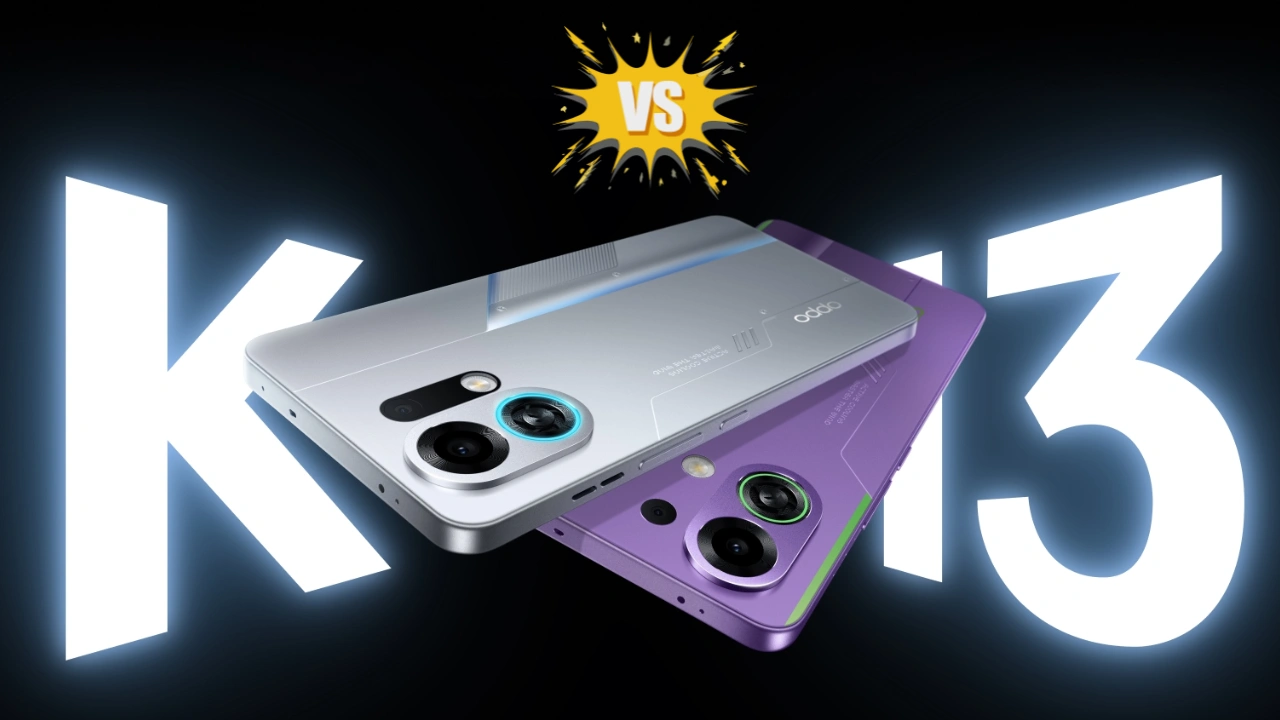OPPO K13 Turbo vs Turbo Pro: Smartphones have become more than just tools for communication — they’re our cameras, gaming consoles, productivity hubs, and even personal style statements. And when a brand like OPPO launches two flagship devices side by side, the curiosity skyrockets.
On 11 August 2025, OPPO dropped two futuristic models in India — OPPO K13 Turbo and OPPO K13 Turbo Pro. At first glance, both seem almost identical: same design language, similar displays, matching camera setups, and even the same battery size. But dig a little deeper, and you’ll find subtle yet important differences that could influence your buying decision.
In this blog, we’ll break down OPPO K13 Turbo vs Turbo Pro in detail so you can decide which one deserves your pocket space (and your budget).
Design & Display: Twins With the Same Fashion Sense
OPPO clearly didn’t want anyone to feel left out in the looks department. Both phones come in the same colors — Silver Knight, Midnight Maverick, and Purple Phantom — giving off that premium vibe. The in-hand feel is slightly big but balanced, with the Turbo weighing 208.5g and the Turbo Pro at 209.4g.
Both feature a 6.8-inch 1.5K AMOLED LTPS display with 120Hz refresh rate, 1600 nits peak brightness, and Dolby Vision. Touch response is snappy, animations are fluid, and outdoor visibility is excellent. Plus, the IPX6, IPX8, and IPX9 certifications mean they can handle accidental splashes or even some rain without fear.
Camera: Same Hardware, Same Results
If photography is your main priority, there’s nothing to debate here — both devices sport the exact same camera setup:
- 50MP OV50D40 main camera
- 2MP depth sensor
- 16MP IMX480 selfie camera
While the hardware is solid, OPPO isn’t pushing these as camera-centric phones. The images are decent, selfies are clear, and colors are natural, but you’re not getting flagship-level magic here. An interesting design touch is the circular cooling fan on the camera module, with a matching circular light — it’s more of a gaming aesthetic choice than a photography feature.
Performance: Where the Real Difference Lies
Here’s where OPPO K13 Turbo vs Turbo Pro starts to get interesting.
The K13 Turbo is powered by the MediaTek Dimensity 8450 chipset, delivering an AnTuTu score of 1,632,996. It’s paired with 8GB LPDDR5X RAM and 128GB/256GB UFS 3.1 storage.
The K13 Turbo Pro, on the other hand, steps up with Snapdragon 8s Gen 4, hitting a much higher AnTuTu score of 2,021,062. You also get more memory options here — 8GB or 12GB LPDDR5X RAM — and faster 256GB UFS 4.0 storage.
Both phones feature an impressive 7,000mm² VC cooling chamber and 19,000mm² graphite layer, keeping temperatures in check during long gaming sessions. They run on ColorOS 15 based on Android 15, with OPPO promising 2 years of major updates and 3 years of security patches.
Ports, Buttons & Extras: Identical Layouts
Both devices have:
- Bottom – Speaker grille, USB Type-C port, microphone, SIM tray
- Left – Microphone
- Top – Noise-cancelling microphone, speaker grille, IR blaster
- Right – Fan outlet (on camera module), power button, volume rocker
For biometrics, you get an in-display fingerprint sensor and face unlock, along with the usual accelerometer, gyro, proximity sensor, and compass.
Battery: Same Beast in Both
The battery is one area where OPPO didn’t differentiate at all — both pack a massive 7000mAh battery with 80W SuperVOOC fast charging and come with a USB Type A-to-C cable in the box. OPPO even claims 5 years of battery durability, which is quite reassuring if you’re planning to hold onto the phone long-term.
Price: The Deciding Factor for Many
The pricing reveals the most practical difference:
- OPPO K13 Turbo starts at ₹27,999 for the 8GB + 128GB variant.
- OPPO K13 Turbo Pro starts at ₹37,999 for the 8GB + 256GB variant.
Bank offers and launch discounts could make both more affordable, but the ₹10,000 gap is something to think about.
OPPO K13 Turbo vs Turbo Pro: Side-by-Side Comparison
| Feature | OPPO K13 Turbo | OPPO K13 Turbo Pro |
|---|---|---|
| Processor | MediaTek Dimensity 8450 (4nm) | Snapdragon 8s Gen 4 (4nm) |
| AnTuTu Score | 1,632,996 | 2,021,062 |
| RAM | 8GB LPDDR5X | 8GB/12GB LPDDR5X |
| Storage | 128GB/256GB UFS 3.1 | 256GB UFS 4.0 |
| Display | 6.8″ 1.5K AMOLED LTPS, 120Hz, 1600 nits, Dolby Vision | Same as Turbo |
| Weight | 208.5g | 209.4g |
| Camera (Rear) | 50MP + 2MP | Same as Turbo |
| Camera (Front) | 16MP | Same as Turbo |
| Cooling | 7,000mm² VC + 19,000mm² graphite | Same as Turbo |
| Battery | 7000mAh, 80W SuperVOOC | Same as Turbo |
| OS | ColorOS 15 (Android 15) | Same as Turbo |
| Price (Base) | ₹27,999 (8GB + 128GB) | ₹37,999 (8GB + 256GB) |
Which One Should You Choose?
If you’re a gamer or heavy multitasker, the Turbo Pro’s Snapdragon 8s Gen 4 with UFS 4.0 storage is going to give you that extra edge in performance and speed. The higher AnTuTu score isn’t just numbers — it translates into smoother gameplay, faster app loads, and better overall responsiveness.
However, if you’re more of a casual user who still wants great performance, the K13 Turbo offers incredible value for money. With the Dimensity 8450, you’ll still get a premium experience without stretching your budget by ₹10,000.
Both phones excel in battery life, cooling, and display quality, so your choice really boils down to how much you value that extra performance boost.
Disclaimer: The specifications and pricing mentioned here are based on official information available at the time of launch on 11 August 2025. Actual user experience may vary depending on software updates, regional variations, and personal usage patterns.
